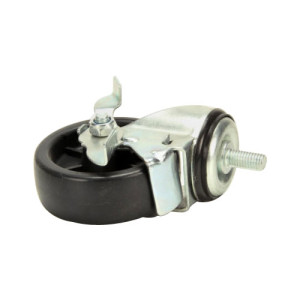
Heat exchangers are devices that transfer heat from a hot to a cold fluid. The refrigerant is returned to the compressor to repeat the cycle. Vaporization requires heat energy, which is extracted from the industrial process load (food items to be cooled). Inside the evaporator, liquid refrigerant vaporizes into a gaseous state. As refrigerant passes through the expansion valve it is further cooled by the Joule Thompson effect, the scientific principle that the temperature of a stream is reduced when forced through a narrow nozzle and allowed to expand. An expansion valve controls the flow of high pressure liquid refrigerant to the evaporator. High pressure refrigerant exits at lower temperature. To facilitate phase change, the condenser dissipates heat energy to ambient air or water. Inside condenser coils gaseous refrigerant condenses to liquid state. Gaseous refrigerant enters the compressor at low pressure and temperature and exits at high pressure and temperature. Compressors (generally) use motor-driven rotating impellers to generate gas pressure. Systems are composed of four basic elements connected with piping into a closed loop that re-circulates refrigerant. Heat energy (latent heat of evaporation) is absorbed as liquid refrigerant undergoes a phase change to a gaseous state. Refrigeration is achieved when the refrigerant, circulating in the system, withdraws heat energy from the chamber to be cooled (load). Mechanical refrigeration units are dedicated systems, installed at individual industrial facilities and owned and operated by the industrial companies. industrial refrigeration is provided by mechanical systems using ammonia as the refrigerant. industrial refrigeration is provided by mechanical systems The purpose of refrigerated cooling systems in food processing is to preserve quality and delay spoilage in volatile organic compounds recovery, is to condense and capture harmful vapor emissions and in the liquid natural gas industry, to facilitate natural gas storage and transportation.ĩ0 percent of U.S. After heat is withdrawn, it is transferred to a condenser and dissipated to air or water. Refrigeration is the withdrawal of heat from a chamber (refrigeration load) to achieve temperatures lower than ambient temperatures. In others, it is a major quality or yield concern. In some cases, mechanical refrigeration systems tend to dehydrate, or strip moisture from that product. Refrigerated cooling systems are widely used technology and present in some form in virtually every food processing plant. On the other hand, the resulting refrigeration is produced at a fraction of the consumable cost of cryogenic refrigeration. Mechanical freezing systems are characterized by a large capital investment, a significant ongoing preventive maintenance cost, and a sizeable permanent commitment of plant space.

The chilled air is continuously passed over the food product, and in doing so, it removes heat. Any system that uses electrical power to produce chilled air, and relies on a refrigerated cooling system.


 0 kommentar(er)
0 kommentar(er)
